A conversation with comic artist H-P Lehkonen, written by Saskia Gullstrand.
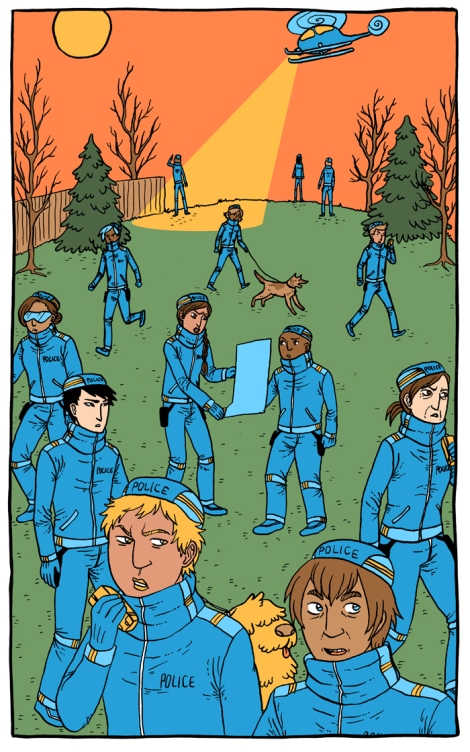
Comic page from The Immortal Nerd by H-P Lehkonen.
Imagine yourself standing at a crossroad, in a city of tall, looming buildings. You are new in this city, even new on this planet, because you grew up on a space station and just moved here to follow your dreams, find yourself and escape some pressure from home to behave like a responsible adult. (Like, why should you have to give up all your fun, just because you recently came of age and gained immortality?) And now you are here, wandering around a bit lost, yes, a bit lost indeed, having to decide wich way to turn next on your way home. To your right side is Happy Street, to your left side is Pain Alley. Which one would you choose to walk down?
If you were the main character Nokia from the web-comic The Immortal Nerd, the answer is clear: Pain Alley sounds familiar, let’s try this cute neighbourhood!
The Immortal Nerd is a dazzling, fast-paced, colourful, hilarious and very emotional adventure, combining elements of sci-fi and slice-of-life with themes such as friendship and coming of age. With deep roots in contemporary internet culture, it is written and drawn by H-P Lehkonen, web-comic artist and feminist activist who lives and works in Helsinki. The story is published by South-Korean webcomic publisher Line Webtoons, and beloved by a vast international readership from all over the world.
Comic artist and pedagouge Lynda Barry once said that reading comics can make an unexpected and sometimes lifesaving difference in people’s lives. Reading The Immortal Nerd made me feel that H-P Lehkonen is very aware of this; and that they are a comic artist who takes every chance to distill a strong life-affirming force and energy into their art. Their characters stride through their adventures with a potent mix of bravado, curiosity, kindness and impulsiveness; fighting trash lords, rescuing ugly cats and bribing police officers with dish washing robots to make them forget the misdeeds of the main characters. H-P creates powerful comics with an expressive and delightful drawing style, attentive portrayals of relationships and the use of humour and diversity to create positive messages.
On a sunny day in September 2016, I met up with H-P in Helsiniki for a couple of milkshakes and an hour of conversation about creating a sci-fi future, comics activism and having webcomics as a day job.
COMICS BRINGS THE MESSAGE FROM THE ACTIVISM TO YOU
S: How would you introduce yourself to someone who doesn’t know who you are?
HP: I could quote my twitter profile description, which is just like: “H-P Lehkonen is a feminist comic artist and activist who works for Line Webtoons from Finland“.
S: What does it mean to you to be a comics activist?
HP: I make feminist conversation through comics. I have a feminist blog, where I publish my own opinions and theories in the form of comics. This way, I make activism more accessible for people who might not be interested in these issues yet, or might find it difficult to participate in the conversation for various of reasons, for example if they are not able-bodied or have a reading dyslexia. Many times, there are really good feminist discussions online or in books, but they are just huge walls of text. As a person with slight dyslexia myself, I find it very difficult to approach those things. Comics are easy to read and bring the message from the activism to you.
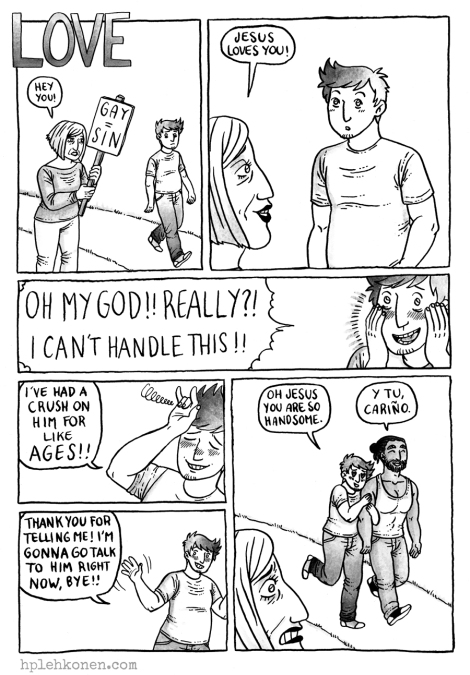
Comic by H-P Lehkonen.
S: Do you feel that there is a special value in portraying your own thoughts, instead of translating someone else’s theories or academic texts into comics?
HP: I feel that it brings it closer to the people, because I draw what I really believe in. Every now and then, of course I just make a funny comic that has nothing to do with anything. Like the latest one I did was about a dream I had about Tom Hiddleston. I just drew that because it was kind of funny and weird. People can come to my blog to enjoy the humour, but also learn something new.
S: What topics have you made comics about?
HP: I do many comics about mental health issues. Recently, I’ve been blogging a lot about emotional abuse on Tumblr, since I have experienced emotional violence myself in two different relationships, and I want to help others understand what it is. Physical abuse or verbal abuse is discussed a lot more in society, but emotional abuse is subtle and goes totally unnoticed. People don’t see the problem if your partner is always telling you: “I love you, but you’re a really difficult person to love. No one else would really love you except for me.“ People thinks that means: “Oh, he just loves me so much, this is wonderful.“ But at the same time, you start feeling that there’s something badly wrong with you, because only this one person could love you.
S: The underlying meaning is that you should feel lucky, cause you are loved by this person but this is your only chance and nobody else would ever want to be with you. What can happen if we don’t talk about emotional abuse?
HP: More and more people will face this, without knowing it’s violence. Both of the destructive relationships I was in ended because of completely different reasons, one was ended by myself and the second by the other person. It took me years to understand that what I had experienced in those relationships actually was emotional abuse and that was the reason I was feeling depressed all the time, and was addicted to the other people in a very unhealthy way. One of them would manipulate me into having fights with my friends, so that I would drift apart from them and be only focused on that one person all the time. That was very horrible. Now I make comics about this, so that people in similar situations can read them and understand what is happening to them. And that it’s not ok if someone treats you that way, you should just leave. If someone is treating you so badly, don’t wait for the change. Leave them instead and let figure out how be a better person by themselves.
THIS SPACE STATION, WHERE EVERYTHING IS TRULY OTHER AND STRANGE
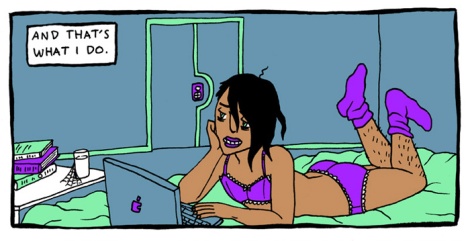
Nokia browsing the internet in The Immortal Nerd by H-P Lehkonen.
S: Can you tell me about your webcomic The Immortal Nerd, that you make for Line Webtoons?
HP: The story takes place in a far, far away future, in the year 4062 and follows Nokia, a history student who studies the culture we live in right now. They have specialized in internet culture and memes. Even though I’m not allowed to do upfront political comics in Webtoons, this still is an activist comic, because personal things are political, and Nokia is a non-binary gender person who was assigned male at birth. There are many transgender people in the story and queer relationships of all kinds.
S: Who is Nokia and how did you create them as a character?
HP: Nokia is based a lot on myself. I’m a genderfluid person, who identify as a non-binary transman, Nokia was created out of my own experience, but I didn’t want my main character to be a boring white person like me, so I made them a mixed-race person. But Nokia is very lazy. They just want to lay in bed all the day and browse through cat videos from the old internet from our time. So our personalites are polar opposites of each other, because I’m a terrible workaholic.
S: Nokia grew up on the space station New Rauma, but when they come of age and gain immortality, they decide to move to the Earth. Why did you make this happen?
HP: I wanted to make a comic about cultural differences, but in a way that makes everyone who reads it feel: “Oh, that’s so funny! Nokia doesn’t understand my culture.“ The Immortal Nerd is published internationally, so the readers are from all over the world. I couldn’t have Nokia moving from India to USA, since then the readers from India would be like: “Of course they don’t understand everything about the USA, because they lived in India.“ That’s why I invented this space station, where everything is truly other and strange. In the story, life on the Earth is also different from how we live today, but it has grown out of our present culture and technology and it is very different from New Rauma.
S: I feel that there are also interesting traces of today’s culture hidden in the society of New Rauma, but it’s clear that the space station and the planet have gone separate ways at some point. How did you decide what each place was going to be like?
HP: The comic is an outgoing and all-around feel-good story, but the reason why these two places are so different is actually really depressing. The people on New Rauma are super rich and the people on Earth are not. On New Rauma, everyone has all the money they could ever want, they can afford anything – that’s why they have immortality and live forever. But on Earth people grow old and die like normal people do. They have really good healthcare and everything, but it’s still not as good as on New Rauma, because they are not as rich. The second main character Piela is from Earth, and she is alway worrying about money, always thinking: “I can’t have two girlfriends because it’s too expensive“ and weird things like that. I have not approached this economical theme seriously at all, but it is the underlying factor of inequality in my story.
S: So the upper class does not even have to be on this planet anymore!
HP: But the Earth also has lower upper class people. For example there is a prospering company that makes vitaminized air and other air products – this company have a lot of money, wealth and power, it owns buildings and everything like that. Jonne, the ex-boyfriend of one of the main characters, works for this company and he is richer than Piela and the others. He’s a horrible person who does not see his own privilege, but instead just thinks everyone else should do what he wants.
S: Jonne is a really tragic person, and a great character. I think you have written a super funny dynamic between him and the other characters. But I’d like to come back to Nokia for a bit… It feels a little embarrassing to compare your characters to others, but Nokia reminded me of the animé version of Usagi, the main character of Sailor Moon. In the animé, she is portrayed as lazy, clumsy and as someone who does not like to study. Instead she loves video games and eating; she’s just an everyday person who wants to have a good time and not think too much about things. But she is also brave and extremely loyal to her friends. Both Usagi and Nokia are important and innovative characters for me, because I often feel that only boys and men are allowed to be both lazy, naive, idealistic and the hero at the same time. But there are very few trans-people or girl characters who are like this.
HP: I actually found Sailor Moon as an adult, but I can see what Usagi and Nokia have in common. They both have a strict sense of justice, so if someone is treating someone else badly, they’ll step in and say: “That’s not ok.“ And they are both lazy. I think the reason why I made Nokia this way, is that it is an easy character type to relate to. All of us feel lazy at some point, and can relate to the feeling of not wanting to do anything except watching cat videos.
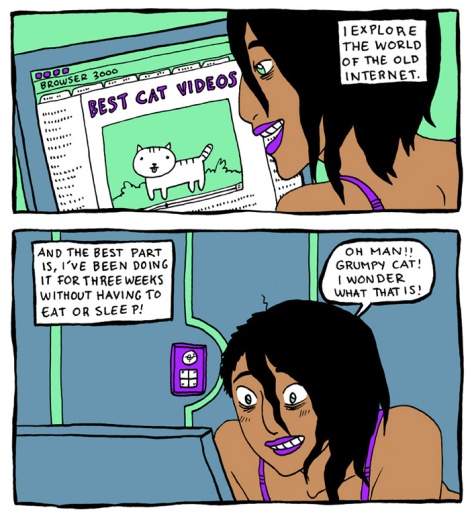
Main character Nokia discovers Grumpy Cat in The Immortal Nerd by H-P Lehkonen.
S: I heard somewhere that if you make a character with many flaws, but portray their growth as a person, then people will relate to them in the strongest way. Would you agree with that?
HP: This is kind of a joke, but when I talk about character creation I always say that you have to have two baskets, one with positive qualities and one with negative qualities. You pick out some positive qualities and give them to your character. Then you take the basket of negative qualities and just throw everything in there, as much as you can. Because most people are very flawed. I feel that I have more negative qualities than positive ones. My friends have more negative qualities than positive ones. But the positive qualities are so big, you don’t have to have many of them. Because they are huge. The negative qualities are smaller. Then of course, if the character were a murderer… that’s a huge negative quality.
S: But if they’re nagging, for example…
HP: … or lazy, or don’t want to shower, like in my comic. They’re minor things. If they are kind, that overcomes all of those negative qualities. Positive qualities are so huge, they are overwhelmingly wonderful things. If your character has a sense of justice, they can be as lazy as they want or watch as many cat videos as they want or be as poor as possible, but they are still a very, very good person.
THEY PAY ME MORE FOR MY WEBCOMIC THAN YOU GET FOR YOUR BOOK
S: Can you tell me a little bit about your publisher Webtoons and how you came to work for them?
HP: Webtoons is a webcomics publisher from South Korea. They became super popular there, to the degree that when someone thinks about reading comics, their first thought is Webtoons. They decided to launch an international site in English, to make everybody in the world know that Webtoons is the place to go if you want to read comics. The interesting fact for other comic artists is that I work for them as an employee in a huge company, not as a freelancer.
S: So they pay you a regular salary ever month to do this webcomic? That’s amazing.
HP: Yes, and I have a boss, and an editor.
S: How did you become an employee there?
HP: They had a competition for sci-fi-comics that I took part with The Immortal Nerd. All my friends were participating, but I found out about the competition very late, so I was in a horrbile hurry when I made the first chapters of the comic. The rule was that you had to publish one episode per week for a month, and I entered during the second week, so I had to make two episodes right away. I actually came up with the idea itself in one day and started drawing. I opened this sketch-book of mine, where I write down all my ideas, and one of the concepts in there was about a vampire that is immortal, but instead of going around killing people, they just browse the internet all day. I liked it and turned it into a scifi. The vampire became a normal human, made immortal by technology. Then I came up with more things along the way.
S: Tell me more about the competition!
HP: 900 people took part of it and I got into the top 16 of most popular comics. But after that I had to quit, because my comic was not getting as many fan votes as others. I was so relieved that the whole thing was over, because it was very stressful to get everyone to vote for my comic all the time. When the competition ended, the top four comic artists got a job at Webtoons, as promised. But the company also contacted me and said: “You didn’t get into the top four, but we liked your comic so much that we’d still like to publish you.“
S: What is your recommendation for a webcomics artist who would like to get paid for their work?
HP: Start a free comic in Webtoons. Within their main site, they keep a smaller website, where anyone can start to publish their own comic. Every month, Webtoons goes there to find new artists. A friend of mine from Brazil got the job this way only last month, and she’s currently negotiating the deal. If you already have one idea that you’re passionate about, work with that. However, if you have a couple of ideas, but are not entirely sure which one to go with, read some of the featured comics that are already getting paid and see what people like to read. Then do something similar, but entirely different. My comic is slice-of-life with jokes in it. That’s exactly what Webtoons are searching for. But at the same time, it’s a new and different story, because it features meme archeology and sci-fi. When Webtoons asked me to work for them, they said: “This is exactly our style, but at the same time it is different from anything we already publish.“
S: How long had your friend had her comic on the website? Was it just one episode, or was it several ones?
HP: You have to publish your comic in there very regularly, so that they know that you’re a trustworthy person who will make their comics on time. My friend was putting her comic in there for three months or something, then they picked her up.
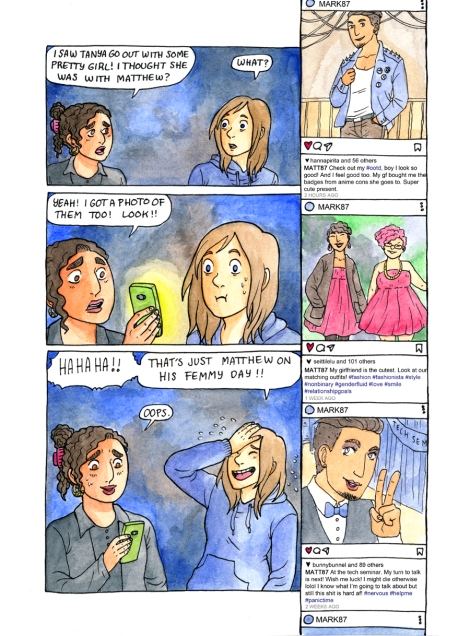
Comic by H-P Lehkonen.
S: How important is it to comics artists today to be published internationally?
HP: I think publishing is moving more and more towards the web. There are so many websites. Hiveworks is one of them, that pay their creators with a slice of their ad money. Next month, a new site is launching called Mary’s Monster.
S: How do you apply to Mary’s Monster and Hiveworks?
HP: They both have special open calls once a year, that you have to wait for. For Webtoons, you can apply anytime by starting a free webcomic there.
S: I feel like the Swedish indie comic scene that I’m part of focus heavily on objects like books and fanzines, but don’t really celebrate webcomics. Why do you think there’s this misunderstanding or lack of knowledge about webcomics?
HP: Everyone can read them for free. To read my comic you don’t have to pay and you don’t even have to see any advertisements. Somehow, because of this, I always have to prove that I’m a serious professional comics artist who’s working with this full time. I have to tell people: “They actually pay me more for my webcomic than you get for your book, that is published on paper.“ It sucks to have to tell people how much I earn to get respect and appreciation for my work. It’s sad, because the people who makes webcomics without a salary work just as hard and are just as much comics artists as I am.
S: What potential do webcomics have as a culture, that makes them different from books?
HP: One of the perks and one of the downsides to web comics is that you normally don’t have an editor. That means you can make all your characters queer and trans, everyone can be people of colour, and no one is going to tell you: “Your super hero can’t be black, that’s not believable.“ You can do whatever you want. But you also don’t get critical feedback, like: “You don’t need a sex scene that goes on for 20 pages, it’s too long. Make it 2 pages.“ Sometimes, you just need to hear what is and what is not working.
S: But I think that editors are lacking in comics in general. Sure, if you publish books, you will have an editor at some point, but still… When I published my graphic short story, the editor was part of my process from the start, she read my sketches and gave feedback during the whole process, but from what I understand this is very unusual. A lot of times, comic artists have to make their whole story before submitting it to a publisher. After that, you can make small changes, but it’s hard to redraw the whole thing if there’s something a bit off with how the drama is unfolding. I would like to see new structures within the comics scene to create this dialogue about how to improve the work. It could be a traditional editor system, but it could also be some other way to get feedback on your work.
HP: I have formed a group in Skype together with a lot of Finnish web comic artists, where people can show their stories and get comments. It’s called Ganbatte!, wich means “Go for it!“ in Japanese. The group has 30 members or something like that. A friend of mine is going to launch a Ganbatte! International, where people can get feedback in English.
S: That’s so great! Could any web comic artist who’s interested join that group?
HP: We don’t know yet, it might be only for people that we already know, so that we can avoid trolls. The Finnish Ganbatte! is a closed group, we don’t take any new members unless it’s people we already know really well.
S: That makes so much sense. Also, there doesn’t have to be one big group with 200 members in the same group, instead there could be several different ones.
HP: I really suggest people to make their own groups. I would love to come to all of them and share my resources.
STRUCTURAL VIOLENCE DOESN’T HAPPEN IN MY COMIC’
S: What is most important to you to talk about, when it comes to your comics?
HP: For me, it’s always the activism. How my comics are about body positivity, diversity and teaching people how to be kind to each other. It’s important to me that the characters in The Immortal Nerd always treat each other with resepct. Except for that one character Jonne. He is the mirror of everyone else, I need this one character who is disrespectful to others, so that people can see: “This is how you do it wrong, and the other characters do it well.“
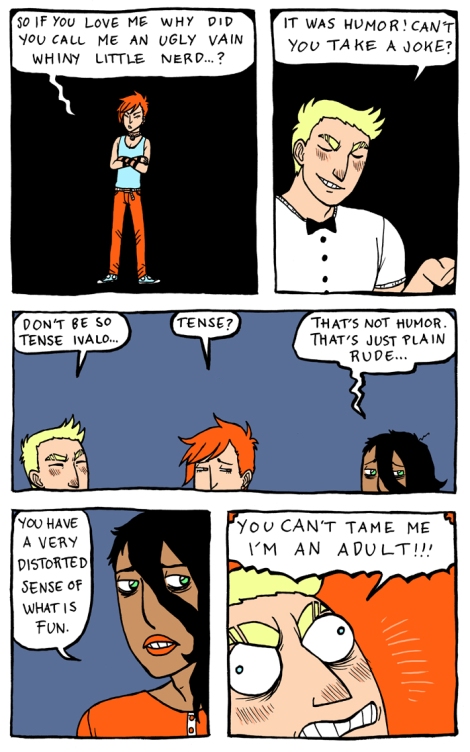
Conflict between Jonne and other characters of The Immortal Nerd by H-P Lehkonen.
S: Yeah, every time Jonne steps into the room, there are ripples from him that affects the relationships in the room. The other character are having a good time and then Jonne comes and is quite mean to them.
HP: Representation is also the most important thing to me; that people who are normally not represented in media can see themselves in the comic. And I want to show the readers that everybody can treat everybody with respect. All the characters respect each others pronouns, noone has ever misgendered anyone in the comic. That is something that I take very seriously, that not even the most evil guy who is rude to people and treats them with the least respect, not even he misgender others. That’s the future that I want to live in, where people appreciate each others identities. Even if they wouldn’t be in good terms with each other, they wouldn’t hit each other under the belt, like misgendering someone. The episode I’m drawing right now, has Jonne saying some really mean things to his ex Ivalo. Because Ivalo likes fashion, Jonne calls him vain. Ivalo likes studying history, so Jonne calls him nerd. He takes important things to Ivalo and he makes them negative, you know. So he is very horrible. But he still doesn’t misgender Ivalo, or say that it’s bad to be gay or something.
S: Would you say there’s a difference between this kind of meanness and structural violence?
HP: Yes, structural violence doesn’t happen in my comic. Because I want to make a comic that people can read safely, without being triggered. Being misgendered is such a huge trigger to many of us. I want people to be able to read it safely and know that those kinds of things won’t happen in this comic. There will be no rape scenes, or something really horrible and triggering like that. People like to shock. They believe that if you want to make a good story, you have to shock people. But you don’t have to do that. You can make really good comics without harming anyone.
S: I think it’s interesting to see the difference between drama, that includes grief, sadness and conflict, and the strucutal violence of transphobia, sexism and racism that you leave out. The Immortal Nerd includes conflict and violence, but whithout reproducing those harmful patterns from daily life.
HP: Yes, and it is true that there is violence in the comic. For example, the battles between the Queen of Clean, who is a wonderful superhero, and the Trash brothers villains. They go into violent fights, where they are hitting each others with fists. But it’s a different kind of violence where somewhat equal, opposing forces are fighting each other. It could have been made in a way where the Trash brothers would attack some of the female characters and disgrace her, rip of their clothes and tie them up, before someone comes to rescue her. That is the kind of violence that I don’t want to do, the traumatic kind of violence that is very unfair.
S: You said before that kindness is such a big quality, that it weighs as much as all the smaller, negative qualities that you can also add to a character. Do you also think that you, as the creator, can have a kindness towards the audience?
HP: I try to live my life so that I am as kind as I can to other people. So I try to be kind to the audience as well by not making them go through traumas. Of course, if someone are triggered by something very obscure, like apples, I can’t know that or prevent it from happening. But I know that misgendering, or rape, or sexual abuse, is very triggering to so many people, and I can just avoid that completely. Why would I make people go through that when I can easily avoid it?
S: Do you think that allows you to explore other things instead?
HP: Yes! The spaces where I could’ve had sexist or homphobic jokes, I fill with kindness and friendships and positive things. What I try to achieve, is to make a comic where you feel positive emotions after you’ve read it. Except that the next episode I’m making will end in a cliffhanger, so you probably won’t feel positive about that.
.
H-P (HANNA-PIRITA) LEHKONEN was born in Ikkeläjärvi, Finland. They make the internationally successfull web comic The Immortal Nerd, that is published online by Line Webbtoons. H-P’s comics are all about diversity, and they love to use humour to convey positive messages. Most of their comics are queer themed and have many characters of different genders and sexualities.
H-P uses comics in their activism and blog about feminist and anti-racist issues in their Finnish comic blog, as well as on their various social media. They also provide resources for other comic artists as the curator of the twitter account @anthologycomics, where they share open calls for anthologies and zines.
